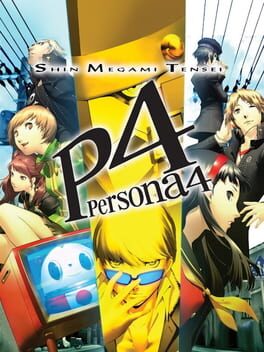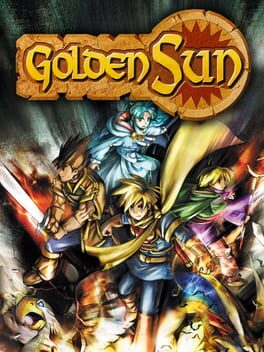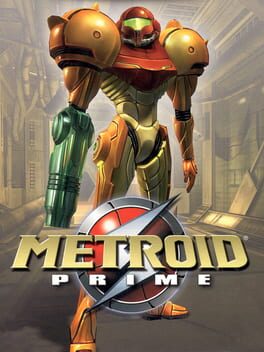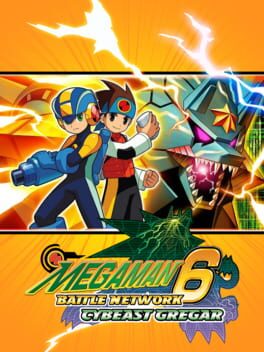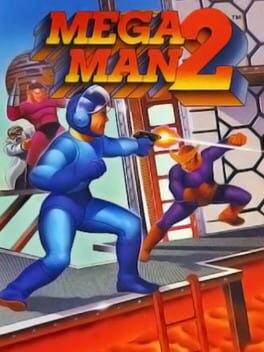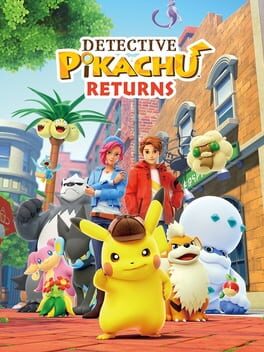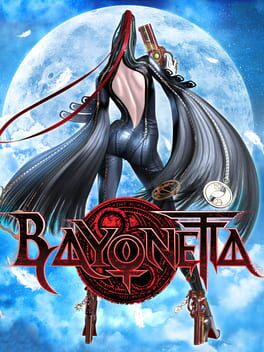Ceredirond
Bio
Nothing here!
Badges

1 Years of Service
Being part of the Backloggd community for 1 year

GOTY '23
Participated in the 2023 Game of the Year Event

Liked
Gained 10+ total review likes

Best Friends
Become mutual friends with at least 3 others

Noticed
Gained 3+ followers
Favorite Games
034
Total Games Played
002
Played in 2024
004
Games Backloggd
Recently Played See More
Recently Reviewed See More
In the year of 200X, a super robot named MegaMan was created. Dr. Light created MegaMan to stop the evil desires of Dr. Wily. However, after his defeat, Dr. Wily created eight of his own robots to counter MegaMan. Cue iconic intro music and thus begins your journey to save the world from Dr. Wily’s nefarious plans again. Dr. Wily’s attempt at taking over the world includes a new cast of robots to stop you. Once again, you must journey as MegaMan and navigate eight stages each headed off by an adversary that matches the stage’s theme, followed up by a gauntlet of obstacles as you storm Dr. Wily’s fortress. MegaMan 2 brings innovation through new powers, brilliant level design, and new obstacles to navigate.
The presentation of the game remains largely the same. The innovation lies within level design and the various abilities MegaMan obtains. Each level has a distinct set of themes with a matching robot boss at the end. Levels range from a factory setting to traversing the skies. These levels contain a collection of enemies waiting to stop you from progressing forward. With fewer hazards flying through the air, it’s easier to identify an enemy and work towards a solution given the environment. Some enemies are skippable while others demand you destroy them first. Certain enemies are reminiscent of their origin and give you an unnecessarily hard time. Still, overall the game is much less hostile towards the player and is more encouraging to approach.
The bosses you face off against at the end of each level are fun and engaging. I faced off against MetalMan and his saw blades to begin the gauntlet and was not disappointed. With MegaMan’s copy ability returning, gaining MetalMan’s power was the most useful ability in the kit. The saw blades deal heavy damage to three of the other robots. Other powers available are unique and offer distinct advantages over other robots and can influence the different stages too. What’s more, the additional abilities you obtain outside of defeating your adversaries are automatically obtained after clearing specific stages. No more searching for missing abilities after reaching an obstacle you are ill-equipped to handle. All of this adds up to a unique experience with banger soundtracks to accompany.
The music of MegaMan 2 is worth noting as it includes some of the most well-known tracks in the series. Each stage has a tune that is unique and fits the present theme. Dr. Wily’s stage theme and the intro themes are easily the most recognizable tracks you will experience. The themes that stick out for me are CrashMan and AirMan. Each track is memorable and will worm its way into your head like it did for me. I believe a lot of soundtracks go unnoticed as they usually do exactly what they need to do to accompany the game (and that’s a good thing!) but it’s always worth mentioning when a soundtrack goes above and beyond that and I firmly believe that MegaMan 2 accomplishes this.
MegaMan 2 is the follow-up you hope to play in a series like the MegaMan. Building off the foundation of core ideas and propelling the series forward with innovation and intrigue was likely to be one of the more gratifying moments for the developers working at Capcom at the time. MegaMan 2 retains its visual and musical aesthetics while giving you a dozen new stages that benefit from greater design and a fantastic soundtrack. Navigation of these stages is improved by great margins and engaging with the bosses provides a thrilling experience. The theming of these levels and bosses work remarkably well with each other. If any game should be used as an example of what it means to make an outstanding sequel, it’s MegaMan 2.
The presentation of the game remains largely the same. The innovation lies within level design and the various abilities MegaMan obtains. Each level has a distinct set of themes with a matching robot boss at the end. Levels range from a factory setting to traversing the skies. These levels contain a collection of enemies waiting to stop you from progressing forward. With fewer hazards flying through the air, it’s easier to identify an enemy and work towards a solution given the environment. Some enemies are skippable while others demand you destroy them first. Certain enemies are reminiscent of their origin and give you an unnecessarily hard time. Still, overall the game is much less hostile towards the player and is more encouraging to approach.
The bosses you face off against at the end of each level are fun and engaging. I faced off against MetalMan and his saw blades to begin the gauntlet and was not disappointed. With MegaMan’s copy ability returning, gaining MetalMan’s power was the most useful ability in the kit. The saw blades deal heavy damage to three of the other robots. Other powers available are unique and offer distinct advantages over other robots and can influence the different stages too. What’s more, the additional abilities you obtain outside of defeating your adversaries are automatically obtained after clearing specific stages. No more searching for missing abilities after reaching an obstacle you are ill-equipped to handle. All of this adds up to a unique experience with banger soundtracks to accompany.
The music of MegaMan 2 is worth noting as it includes some of the most well-known tracks in the series. Each stage has a tune that is unique and fits the present theme. Dr. Wily’s stage theme and the intro themes are easily the most recognizable tracks you will experience. The themes that stick out for me are CrashMan and AirMan. Each track is memorable and will worm its way into your head like it did for me. I believe a lot of soundtracks go unnoticed as they usually do exactly what they need to do to accompany the game (and that’s a good thing!) but it’s always worth mentioning when a soundtrack goes above and beyond that and I firmly believe that MegaMan 2 accomplishes this.
MegaMan 2 is the follow-up you hope to play in a series like the MegaMan. Building off the foundation of core ideas and propelling the series forward with innovation and intrigue was likely to be one of the more gratifying moments for the developers working at Capcom at the time. MegaMan 2 retains its visual and musical aesthetics while giving you a dozen new stages that benefit from greater design and a fantastic soundtrack. Navigation of these stages is improved by great margins and engaging with the bosses provides a thrilling experience. The theming of these levels and bosses work remarkably well with each other. If any game should be used as an example of what it means to make an outstanding sequel, it’s MegaMan 2.
This review contains spoilers
After five (mostly) good entries it’s only natural to expect great things from a sixth and final installment to a tenured franchise such as Mega Man Battle Network. Yet, just because it’s a capstone entry does not guarantee success or quality. Mega Man Battle Network 6: Cybeast Gregar is a mixed bag of good and bad overall with the bad often undermining the good. Despite personal enjoyment and affection, I wish I could have gotten more out of my experience that rounds off this retrospective spanning almost a year. Improvements to existing systems and the return of proven systems make for a compelling reason to love this game. Poor writing and narrative design paired with questionable overall design choices limit how much you can engage with and appreciate those positive changes. After all, a game can feel good while still being bad. I insist that this Mega Man entry is good while leaving much to be desired.
The introduction brings about radical changes which feel necessary for the driving force behind the plot. For there to be titan programs capable of the sheer destruction and power demonstrated, it would almost certainly be required for them to exist somewhere we haven’t been to before. The Cybeasts, named Gregar and Falzar, still demand suspension of disbelief that you, the son of one of the greatest scientists in the world, would never have heard of these monsters before. In light of all that Lan has accomplished, it begs you to not consider this while proceeding with the plot. Regardless, the concept of MegaMan absorbing one of these great beasts is almost just as unbelievable were they not to give some sort of reason for it to work. At a surface level, this feels like a contrivance but given the history of MegaMan’s origins, it comes off as believable enough to move on from it.
The new characters that are introduced in this new setting have the potential to be compelling friends and allies, were they given more time to form attachments like that of Lan’s ACDC Town friends. Unfortunately, the narrative rushes you from the setup scenario to the crisis scenario before urgently pushing you to the next area so you can repeat the same formula until you reach the bittersweet end. The spaces occupied by these scenarios become bland the moment you resolve the crisis. These areas exist solely for the sake of the plot as the added NPCs do little to contribute to the intended “lived-in” feeling. We see this type of setup in previous Battle Network games too but usually, there’s a little bit more to justify the setting beyond the facilities that are rooted in these spaces. Places like Yoka in 3 have the zoo and the hotel with the hot springs and 5’s SciLab has a pathway to the marina. Nothing like that exists within Battle Network 6 and the game is worse for it. None of these places feel connected to each other either as half of these places are in unconventional spaces like the sky or out in nature.
The themes present in these areas go beyond their appearance too. This is most apparent in the Green Area where Cyber City’s justice system resides. The themes present in Green Area go further than what I imagine the developers intended. The idea of using program-based judgment works when you consider how all of net society relies on technology and its integrations into a daily living but when you take a step back and consider the social ramifications behind computer-based judgment it becomes immediately off-putting. Who put in the parameters that define justice? Is the computer capable of understanding nuance and contextualization? What happens when the computer reaches the wrong verdict? Furthermore, is it ethical for a prosecutor to create such a system and still do their job under the pretense that they designed that system? These are all questions that I don’t believe were intended to be explored by this area, especially with how quickly the plot resolves and the game moves on. All of these factors don’t even acknowledge the fact that justice has been weirdly married to environmentalism. None of this translates to the net aside from the background and a few cyber-trees that block your path.
The net design is perhaps, the greatest it’s been since Battle Network 3. While visually it’s about what you have grown to expect throughout the series, the layout is highly intuitive and is easy to follow and remember how to navigate. Obstacles are less present in favor of offering you shortcuts to navigate through areas quickly. The rush biscuits open up the opportunity to spend your gratuitous amount of money accrued from battle and then create paths that allow you to find otherwise inaccessible items or spaces. This is a completely missable feature but it’s incredibly useful for those repeat journeys through the net. Obstacles can also be cleared by using one of the various Link Navis that you obtain throughout the game. The Link Navi system is the continuation of Battle Network 5’s system that allowed Lan to operate other characters’ Navis. In this game, Lan is permitted to explore the net with some returning characters along with some new faces. Getting to run around as Navis such as HeatMan and ElecMan was a pleasant way to change up the gameplay and challenge you to synergize with these Navis. This also allowed you to clear the barriers that were present throughout the net. This could be tedious at times due to the static starting point of each Navi but it overall lends itself to a pleasant experience. Of course, the best part of exploring the net is busting viruses and gathering battle chips.
Gathering battle chips has never been better. The chip selection, accessibility, and synergy are next level. From the beginning, it’s easy to narrow your folder down to a couple of chip codes. Regular memory is available in abundance and the new tag system makes it even easier for you to put together Program Advances or set up to use chips more efficiently, all of which adds up to an excellent combat system. The problem is that the battle chips are too strong. Immediately upon arrival, you can gather chips that do sixty or more damage. Your folder starts with very fast-acting chips that do a lot of damage as well. This is most present with new chips. A lot of the Navi boss chips do a ton of damage and have low regular memory requirements. Like BlastMan, his basic chips do a lot of damage and only require 30MB to select as your regular chip. This allows for combat to be heavily trivialized and undermines any need for other systems that are present in combat. Namely, the Double Soul system that was rebranded to the Cross system and the new Beast Mode that is introduced when MegaMan absorbs Cybeast Gregar.
The Cross system is a feature that’s introduced with the Link Navis. It allows MegaMan to adopt the physical properties of the Link Navis and boosts the power of their respective elements. The crosses you obtain throughout the game are very powerful in their own respect. Specifically, HeatCross and SlashCross are the first two you can obtain and are incredibly strong. If there were tougher viruses to face the Cross system would have been critical to helping you compete but as mentioned before, battle chips are so strong that you only feel the need to use this system during boss battles. Any other time the animations and process of using the ability would take longer than the battle itself. This system synergizes well with Beast Mode though. Beast Mode boosts the strength of elementless chips and also gives you the ability to jump into the effective damage range of a chip before using it. This aids in hitting enemies while you’re also taking evasive action but it could also leave you vulnerable for an attack. The strongest implementation is the combining of the two systems. Combining a Cross with Beast Mode changes how the affected chips work. Depending on which Cross you use, combined with Beast Mode greatly magnifies the effects and strength of your battle chips. Effects like turning your chips into a seven-tile burning attack or adding a stunning effect to your electric chips. This is well presented and fun to use but it further trivializes content. All of these factors rush you through the game until you reach the end.
After facing off with the titular Cybeast, Gregar, you have finally reached the end of not only Mega Man Battle Network 6: Cybeast Gregar, but you’ve also reached the end of the Battle Network series as a whole. While the franchise has had many ups and downs, this particular title perhaps has the deepest valleys in terms of storytelling while having the highest peaks in terms of gameplay elements. The gameplay feels so good that if you’re not paying attention you could miss just how poorly the writing and execution of this game’s narrative is. Breaking an established character’s behavior in an attempt to misdirect and then justifying it with an incredibly vague backstory is more frustrating than anything that has been done, narratively speaking, in the entire series. This is compounded by the fact that they gave this backstory to two different characters. At least with one of those characters it works because that character wasn’t established as morally grounded as the other character was. Then to right the wrong the characters basically admit because an eleven-year-old said it was bad and they should feel bad, that they were bad and feel bad for their part in the main villain’s plot.
Afterward, we’re given a few scenes that depict Lan and all of his friends talking about what they want to do when they grow up and the game ties it off with a proverbial bow that reads “and so they did.” It’s about as fulfilling as the narrative that we just experienced and it reminds you of how haphazardly this story has been put together. Between the linear area introductions and the immediate crisis that resolves just as swiftly, you’re left with a sentiment akin to “That’s it?” when the sentiment should be one of amazement. The Battle Network series as a whole has been a worthwhile experience, yet with this conclusion I’m left dissatisfied and desiring a follow-up containing a stronger ending. For as much fun as Mega Man Battle Network 6: Cybeast Gregar was to play, as a final installment to an otherwise fantastic series I am left sorely disappointed.
The introduction brings about radical changes which feel necessary for the driving force behind the plot. For there to be titan programs capable of the sheer destruction and power demonstrated, it would almost certainly be required for them to exist somewhere we haven’t been to before. The Cybeasts, named Gregar and Falzar, still demand suspension of disbelief that you, the son of one of the greatest scientists in the world, would never have heard of these monsters before. In light of all that Lan has accomplished, it begs you to not consider this while proceeding with the plot. Regardless, the concept of MegaMan absorbing one of these great beasts is almost just as unbelievable were they not to give some sort of reason for it to work. At a surface level, this feels like a contrivance but given the history of MegaMan’s origins, it comes off as believable enough to move on from it.
The new characters that are introduced in this new setting have the potential to be compelling friends and allies, were they given more time to form attachments like that of Lan’s ACDC Town friends. Unfortunately, the narrative rushes you from the setup scenario to the crisis scenario before urgently pushing you to the next area so you can repeat the same formula until you reach the bittersweet end. The spaces occupied by these scenarios become bland the moment you resolve the crisis. These areas exist solely for the sake of the plot as the added NPCs do little to contribute to the intended “lived-in” feeling. We see this type of setup in previous Battle Network games too but usually, there’s a little bit more to justify the setting beyond the facilities that are rooted in these spaces. Places like Yoka in 3 have the zoo and the hotel with the hot springs and 5’s SciLab has a pathway to the marina. Nothing like that exists within Battle Network 6 and the game is worse for it. None of these places feel connected to each other either as half of these places are in unconventional spaces like the sky or out in nature.
The themes present in these areas go beyond their appearance too. This is most apparent in the Green Area where Cyber City’s justice system resides. The themes present in Green Area go further than what I imagine the developers intended. The idea of using program-based judgment works when you consider how all of net society relies on technology and its integrations into a daily living but when you take a step back and consider the social ramifications behind computer-based judgment it becomes immediately off-putting. Who put in the parameters that define justice? Is the computer capable of understanding nuance and contextualization? What happens when the computer reaches the wrong verdict? Furthermore, is it ethical for a prosecutor to create such a system and still do their job under the pretense that they designed that system? These are all questions that I don’t believe were intended to be explored by this area, especially with how quickly the plot resolves and the game moves on. All of these factors don’t even acknowledge the fact that justice has been weirdly married to environmentalism. None of this translates to the net aside from the background and a few cyber-trees that block your path.
The net design is perhaps, the greatest it’s been since Battle Network 3. While visually it’s about what you have grown to expect throughout the series, the layout is highly intuitive and is easy to follow and remember how to navigate. Obstacles are less present in favor of offering you shortcuts to navigate through areas quickly. The rush biscuits open up the opportunity to spend your gratuitous amount of money accrued from battle and then create paths that allow you to find otherwise inaccessible items or spaces. This is a completely missable feature but it’s incredibly useful for those repeat journeys through the net. Obstacles can also be cleared by using one of the various Link Navis that you obtain throughout the game. The Link Navi system is the continuation of Battle Network 5’s system that allowed Lan to operate other characters’ Navis. In this game, Lan is permitted to explore the net with some returning characters along with some new faces. Getting to run around as Navis such as HeatMan and ElecMan was a pleasant way to change up the gameplay and challenge you to synergize with these Navis. This also allowed you to clear the barriers that were present throughout the net. This could be tedious at times due to the static starting point of each Navi but it overall lends itself to a pleasant experience. Of course, the best part of exploring the net is busting viruses and gathering battle chips.
Gathering battle chips has never been better. The chip selection, accessibility, and synergy are next level. From the beginning, it’s easy to narrow your folder down to a couple of chip codes. Regular memory is available in abundance and the new tag system makes it even easier for you to put together Program Advances or set up to use chips more efficiently, all of which adds up to an excellent combat system. The problem is that the battle chips are too strong. Immediately upon arrival, you can gather chips that do sixty or more damage. Your folder starts with very fast-acting chips that do a lot of damage as well. This is most present with new chips. A lot of the Navi boss chips do a ton of damage and have low regular memory requirements. Like BlastMan, his basic chips do a lot of damage and only require 30MB to select as your regular chip. This allows for combat to be heavily trivialized and undermines any need for other systems that are present in combat. Namely, the Double Soul system that was rebranded to the Cross system and the new Beast Mode that is introduced when MegaMan absorbs Cybeast Gregar.
The Cross system is a feature that’s introduced with the Link Navis. It allows MegaMan to adopt the physical properties of the Link Navis and boosts the power of their respective elements. The crosses you obtain throughout the game are very powerful in their own respect. Specifically, HeatCross and SlashCross are the first two you can obtain and are incredibly strong. If there were tougher viruses to face the Cross system would have been critical to helping you compete but as mentioned before, battle chips are so strong that you only feel the need to use this system during boss battles. Any other time the animations and process of using the ability would take longer than the battle itself. This system synergizes well with Beast Mode though. Beast Mode boosts the strength of elementless chips and also gives you the ability to jump into the effective damage range of a chip before using it. This aids in hitting enemies while you’re also taking evasive action but it could also leave you vulnerable for an attack. The strongest implementation is the combining of the two systems. Combining a Cross with Beast Mode changes how the affected chips work. Depending on which Cross you use, combined with Beast Mode greatly magnifies the effects and strength of your battle chips. Effects like turning your chips into a seven-tile burning attack or adding a stunning effect to your electric chips. This is well presented and fun to use but it further trivializes content. All of these factors rush you through the game until you reach the end.
After facing off with the titular Cybeast, Gregar, you have finally reached the end of not only Mega Man Battle Network 6: Cybeast Gregar, but you’ve also reached the end of the Battle Network series as a whole. While the franchise has had many ups and downs, this particular title perhaps has the deepest valleys in terms of storytelling while having the highest peaks in terms of gameplay elements. The gameplay feels so good that if you’re not paying attention you could miss just how poorly the writing and execution of this game’s narrative is. Breaking an established character’s behavior in an attempt to misdirect and then justifying it with an incredibly vague backstory is more frustrating than anything that has been done, narratively speaking, in the entire series. This is compounded by the fact that they gave this backstory to two different characters. At least with one of those characters it works because that character wasn’t established as morally grounded as the other character was. Then to right the wrong the characters basically admit because an eleven-year-old said it was bad and they should feel bad, that they were bad and feel bad for their part in the main villain’s plot.
Afterward, we’re given a few scenes that depict Lan and all of his friends talking about what they want to do when they grow up and the game ties it off with a proverbial bow that reads “and so they did.” It’s about as fulfilling as the narrative that we just experienced and it reminds you of how haphazardly this story has been put together. Between the linear area introductions and the immediate crisis that resolves just as swiftly, you’re left with a sentiment akin to “That’s it?” when the sentiment should be one of amazement. The Battle Network series as a whole has been a worthwhile experience, yet with this conclusion I’m left dissatisfied and desiring a follow-up containing a stronger ending. For as much fun as Mega Man Battle Network 6: Cybeast Gregar was to play, as a final installment to an otherwise fantastic series I am left sorely disappointed.
This review contains spoilers
Achieving the zenith in a series is often a lofty goal and realizing the true potential of anything can be a challenge. It’s great when you can reach a culminating point in a project while also achieving greater heights. When considering a series like Pikmin, it’s easy to dive into the philosophies and central themes but recognizing the merits of their innovative systems and the way they compel you to participate in them is a higher point for each entry. With each game building off the last, Pikmin 4 is the zenith of the series. While it’s not without fault, Pikmin 4 is the ultimate culmination of every concept achieved throughout the series thus far. With a strong compelling narrative, and fluid, cohesive gameplay, matched with stunning visuals, Pikmin 4 offers the most comprehensive and engaging experience of the series.
The introductory sequence is shaky with many cutscenes and tutorials that disrupt the flow of gameplay. Once you make it through the first couple of days of exploration you are given the freedom to approach the available areas in whichever fashion you deem appropriate. With all previous Pikmin types returning, the game brings about big changes to the formula for expanding your capabilities. The first thing they do is introduce you to the biggest new feature, space dogs! Instead of having extra leaders to do tasks with, you have a trusty companion who works independently and cooperatively with your self-made main character. Oatchi has a lot of unique capabilities like being able to take treasure back to the ship and return to you without having to take control of him first. You can also ride on his back with your Pikmin and carry them for more accurate navigation around hazards or enemies. This allows for different obstacles and pushes you to form a cohesive plan on what you want to accomplish before nightfall.
Nightfall brings a brand new type of mission where you go out and take on creatures that stir up at night. You are introduced to a new Pikmin type, Glow Pikmin, that are immune to hazards and have a neat ability to immediately return to the player. These Pikmin can only be found during these night missions where your goal is to protect a plant-like structure called a Lumiknoll. The missions in the first few areas are pretty straightforward, you collect crystals and kill enemies as they make their way to the Lumiknoll. As things go on, you eventually are tasked with protecting two Lumiknolls at a time during certain missions which challenges your ability to change focus between two defense points. Your reward for surviving until daybreak is this sap that’s excreted by the Lumiknolls so long as they survive the night. With this sap, you’re able to generate medicine for characters that have been infected with a condition that has been plaguing people who crash-landed on PNF-404.
Leaflings are people who have been infected with a condition that covers their body with leaves and makes them obsessed with Pikmin 4’s (along with the entire series) most present and consistent theme. Dandori is the art of organizing tasks strategically and working effectively to execute a plan. While this idea and concept has been present in every game prior, Pikmin 4 is the first to use the term explicitly. The main idea is to make the most of your time and resources. Your character is part of a rescue organization that was sent after receiving Captain Olimar’s SOS signal at the beginning of the game. Upon arrival, you learn that many people have crash-landed on PNF-404 and they all need rescuing. Leaflings are mixed in with several of these characters and the only way to cure them is with the Lumiknoll sap. So during the day you are finding and rescuing castaways, and at night you are finding the materials to cure the castaways that have been turned into Leaflings. Most of these leaflings demand that you demonstrate your Dandori abilities before they can be brought in for treatment.
These challenges consist of a variety of objectives that include retrieving as many treasures as you can or defeating as many enemies as you can within the time limit. Each area has a few of these challenges along with one Dandori Battle challenge. The Dandori Battle challenges are how the game incorporates multiplayer battle into the core gameplay where you’re tasked with collecting more treasure than your opponent. It’s a nice way for players to learn how Battle mode works without the stress of having to compete against real people. In the main story, your opponent is a leafling that looks strangely familiar. He consistently has a castaway hostage and always turns them into a leafling. The battles themselves are fairly easy as the opponent seldom tries to interfere with your gathering so most often you can bully him by just stealing whatever his Pikmin are carrying by outnumbering them with your own. Later in the game, they introduce new battle mechanics like a bomb that can make the opponent lose some of their points in the form of stealable treasures, a golden pear that’s worth a large chunk of points, and a bonus multiplier that changes throughout the battle that indicates collectibles worth double points. All of these challenges are designed around the central philosophy of Dandori. So much so that once you’ve beaten the game you unlock a series of exceedingly difficult challenges.
Immediately after beating the main story, the post-game grants access to Olimar’s Shipwreck Tale. This is a condensed callback to the first Pikmin game where you are tasked with collecting the thirty missing ship parts before Olimar’s oxygen depletes. In the original Pikmin, you had thirty days to complete this task. This time around you only have fifteen days. While this remains ample time, it leaves less margin for careless use of your time like the main narrative affords you. Once you complete this segment you are granted access to the Sage Leaf Trials. This gauntlet consisting of ten of the most difficult challenges present in the series truly puts your mastery of Dandori to the test. Most of these challenges took me several tries and gave me the impression that they are meant to be completed once you’ve finished the post-game narrative. These challenges operate on the assumption that you have obtained all of the upgrades for Oatchi and yourself and it necessitates the implementation of all that you’ve learned. The rewards you get for completing these challenges are appropriate for the difficulty presented. Still, by then you’re playing more for the satisfaction of beating the challenges than what the game has to offer. The way these challenges are positioned in the game and how they are presented, make for a great capstone of what it means to play Pikmin and make for solid endgame content as a whole.
In the endgame, your team returns to PNF-404 because Oatchi seems to be afflicted by the same disease as the castaways. This brings you to explore two more areas in the game before you’ve truly beaten it. These areas were well presented much like the main areas but they were not as impressive. Serene Shores and Hero’s Hideaway were both beautifully designed areas in ways that we had never experienced before. The theming and execution of these areas feel inspired and remind you of the capabilities of the series. Paired with the caves that return from Pikmin 2, you’re given a wide berth of spaces to explore. Caves make a great return to the series. They’re not procedurally generated like they were before and they’re generally shorter. Each floor is less complex but feels more focused on what challenges are presented and of course, comes with a large cast of enemies and bosses. The enemies feel the least threatening in this game as you have so many different answers to them. The more complicated enemies are less threatening to your Pikmin and the bosses can be rushed down so fast that you’re not likely to lose any Pikmin to them either. The only way the game made any of these challenges hard was to deprive you of the space to fight the boss. Yet, at that point, you’re better off using the copious amounts of items you have access to so that you don’t even have to bother. While this doesn’t necessarily take away from the enjoyment of the game, it does reduce tension as you work your way down to the final boss.
The Ancient Sirehound lurks at the bottom of the game’s final cave. We need a cell sample so that we can create a cure for Oatchi but Louie is down there causing mayhem. The cave itself is longer than any other dungeon in the game and rehashes a lot of older bosses from previous Pikmin titles. At the end, you face off with the Ancient Sirehound. This boss was visually and thematically well put together. Mechanically it leaves much to be desired as the powers presented don’t make sense to the creature, nor do they serve as real obstacles. The boss has more health than any other boss we’ve encountered but falls short in the repetitive nature of fighting it. This is emblematic of combat as a whole being significantly less challenging than before. There’s little satisfaction to be had from defeating this beast since it doesn’t challenge your ability to employ your forces like the Plasm Wraith or the Titan Dweevil do and you never find out why Louie is operating against you and Olimar. Despite the absence of challenge, I wouldn’t say anything in this game lacks enjoyment nor do these final moments feel inconclusive to the game.
Recognizing what makes each game good while acknowledging its faults, Pikmin 4 easily boasts the most content and accessibility of the series thus far. It’s the zenith of this type of success that begs for innovation in the form of departure. While that’s certainly not the only direction the series could go, I’d be impressed if something like this could be accomplished again. Pikmin remains one of the most endearing and visually appealing franchises in Nintendo’s roster of independent properties. While Pikmin 4 boasts a great array of features and content, it doesn’t necessarily capture the spirit of the series the same way that its first two entries do. Pikmin 4 is unequivocally the best Pikmin game due to its ability to provide all that previous entries have brought before it, yet still leaves enough to be desired for more in the future.
The introductory sequence is shaky with many cutscenes and tutorials that disrupt the flow of gameplay. Once you make it through the first couple of days of exploration you are given the freedom to approach the available areas in whichever fashion you deem appropriate. With all previous Pikmin types returning, the game brings about big changes to the formula for expanding your capabilities. The first thing they do is introduce you to the biggest new feature, space dogs! Instead of having extra leaders to do tasks with, you have a trusty companion who works independently and cooperatively with your self-made main character. Oatchi has a lot of unique capabilities like being able to take treasure back to the ship and return to you without having to take control of him first. You can also ride on his back with your Pikmin and carry them for more accurate navigation around hazards or enemies. This allows for different obstacles and pushes you to form a cohesive plan on what you want to accomplish before nightfall.
Nightfall brings a brand new type of mission where you go out and take on creatures that stir up at night. You are introduced to a new Pikmin type, Glow Pikmin, that are immune to hazards and have a neat ability to immediately return to the player. These Pikmin can only be found during these night missions where your goal is to protect a plant-like structure called a Lumiknoll. The missions in the first few areas are pretty straightforward, you collect crystals and kill enemies as they make their way to the Lumiknoll. As things go on, you eventually are tasked with protecting two Lumiknolls at a time during certain missions which challenges your ability to change focus between two defense points. Your reward for surviving until daybreak is this sap that’s excreted by the Lumiknolls so long as they survive the night. With this sap, you’re able to generate medicine for characters that have been infected with a condition that has been plaguing people who crash-landed on PNF-404.
Leaflings are people who have been infected with a condition that covers their body with leaves and makes them obsessed with Pikmin 4’s (along with the entire series) most present and consistent theme. Dandori is the art of organizing tasks strategically and working effectively to execute a plan. While this idea and concept has been present in every game prior, Pikmin 4 is the first to use the term explicitly. The main idea is to make the most of your time and resources. Your character is part of a rescue organization that was sent after receiving Captain Olimar’s SOS signal at the beginning of the game. Upon arrival, you learn that many people have crash-landed on PNF-404 and they all need rescuing. Leaflings are mixed in with several of these characters and the only way to cure them is with the Lumiknoll sap. So during the day you are finding and rescuing castaways, and at night you are finding the materials to cure the castaways that have been turned into Leaflings. Most of these leaflings demand that you demonstrate your Dandori abilities before they can be brought in for treatment.
These challenges consist of a variety of objectives that include retrieving as many treasures as you can or defeating as many enemies as you can within the time limit. Each area has a few of these challenges along with one Dandori Battle challenge. The Dandori Battle challenges are how the game incorporates multiplayer battle into the core gameplay where you’re tasked with collecting more treasure than your opponent. It’s a nice way for players to learn how Battle mode works without the stress of having to compete against real people. In the main story, your opponent is a leafling that looks strangely familiar. He consistently has a castaway hostage and always turns them into a leafling. The battles themselves are fairly easy as the opponent seldom tries to interfere with your gathering so most often you can bully him by just stealing whatever his Pikmin are carrying by outnumbering them with your own. Later in the game, they introduce new battle mechanics like a bomb that can make the opponent lose some of their points in the form of stealable treasures, a golden pear that’s worth a large chunk of points, and a bonus multiplier that changes throughout the battle that indicates collectibles worth double points. All of these challenges are designed around the central philosophy of Dandori. So much so that once you’ve beaten the game you unlock a series of exceedingly difficult challenges.
Immediately after beating the main story, the post-game grants access to Olimar’s Shipwreck Tale. This is a condensed callback to the first Pikmin game where you are tasked with collecting the thirty missing ship parts before Olimar’s oxygen depletes. In the original Pikmin, you had thirty days to complete this task. This time around you only have fifteen days. While this remains ample time, it leaves less margin for careless use of your time like the main narrative affords you. Once you complete this segment you are granted access to the Sage Leaf Trials. This gauntlet consisting of ten of the most difficult challenges present in the series truly puts your mastery of Dandori to the test. Most of these challenges took me several tries and gave me the impression that they are meant to be completed once you’ve finished the post-game narrative. These challenges operate on the assumption that you have obtained all of the upgrades for Oatchi and yourself and it necessitates the implementation of all that you’ve learned. The rewards you get for completing these challenges are appropriate for the difficulty presented. Still, by then you’re playing more for the satisfaction of beating the challenges than what the game has to offer. The way these challenges are positioned in the game and how they are presented, make for a great capstone of what it means to play Pikmin and make for solid endgame content as a whole.
In the endgame, your team returns to PNF-404 because Oatchi seems to be afflicted by the same disease as the castaways. This brings you to explore two more areas in the game before you’ve truly beaten it. These areas were well presented much like the main areas but they were not as impressive. Serene Shores and Hero’s Hideaway were both beautifully designed areas in ways that we had never experienced before. The theming and execution of these areas feel inspired and remind you of the capabilities of the series. Paired with the caves that return from Pikmin 2, you’re given a wide berth of spaces to explore. Caves make a great return to the series. They’re not procedurally generated like they were before and they’re generally shorter. Each floor is less complex but feels more focused on what challenges are presented and of course, comes with a large cast of enemies and bosses. The enemies feel the least threatening in this game as you have so many different answers to them. The more complicated enemies are less threatening to your Pikmin and the bosses can be rushed down so fast that you’re not likely to lose any Pikmin to them either. The only way the game made any of these challenges hard was to deprive you of the space to fight the boss. Yet, at that point, you’re better off using the copious amounts of items you have access to so that you don’t even have to bother. While this doesn’t necessarily take away from the enjoyment of the game, it does reduce tension as you work your way down to the final boss.
The Ancient Sirehound lurks at the bottom of the game’s final cave. We need a cell sample so that we can create a cure for Oatchi but Louie is down there causing mayhem. The cave itself is longer than any other dungeon in the game and rehashes a lot of older bosses from previous Pikmin titles. At the end, you face off with the Ancient Sirehound. This boss was visually and thematically well put together. Mechanically it leaves much to be desired as the powers presented don’t make sense to the creature, nor do they serve as real obstacles. The boss has more health than any other boss we’ve encountered but falls short in the repetitive nature of fighting it. This is emblematic of combat as a whole being significantly less challenging than before. There’s little satisfaction to be had from defeating this beast since it doesn’t challenge your ability to employ your forces like the Plasm Wraith or the Titan Dweevil do and you never find out why Louie is operating against you and Olimar. Despite the absence of challenge, I wouldn’t say anything in this game lacks enjoyment nor do these final moments feel inconclusive to the game.
Recognizing what makes each game good while acknowledging its faults, Pikmin 4 easily boasts the most content and accessibility of the series thus far. It’s the zenith of this type of success that begs for innovation in the form of departure. While that’s certainly not the only direction the series could go, I’d be impressed if something like this could be accomplished again. Pikmin remains one of the most endearing and visually appealing franchises in Nintendo’s roster of independent properties. While Pikmin 4 boasts a great array of features and content, it doesn’t necessarily capture the spirit of the series the same way that its first two entries do. Pikmin 4 is unequivocally the best Pikmin game due to its ability to provide all that previous entries have brought before it, yet still leaves enough to be desired for more in the future.
